|
|
| How quickly does avant-garde age? Alise Tīfentāle, Art Historian Art of Another Kind: International Abstraction and the Guggenheim, 1949–1960 08.06.–12.09.2012. Solomon R. Guggenheim Museum, New York | |
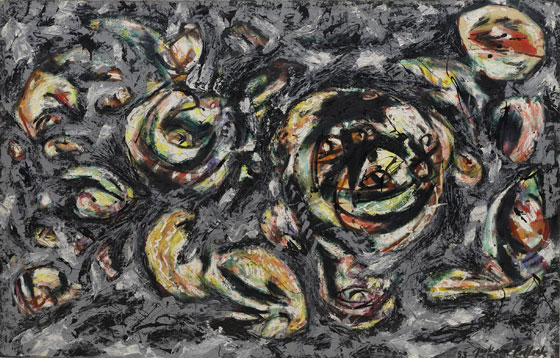 Jackson Pollock. Ocean Greyness. Oil on canvas. 146.7x229 cm. 1953 Publicity photos Courtesy of the Pollock-Krasner Foundation; Artists Rights Society (ARS), New York | |
| The exhibition Art of Another Kind offered a retrospective of the ideals of postwar American art, which are related among other things also to the establishment of the Solomon R. Guggenheim Museum in New York City. The 1950s were the heyday and triumph of American abstract expressionism in the so-called free world, and a general belief in abstract art as the ultimate manifestation of an individual’s creative and political freedom. A time when the artist, the lonely genius, suffers while creating wonderful pieces of abstract expressionism or colour field painting which not only reflect an individual’s emotional experience and vision, but are also able to reassert, the whole world over, the reputation of the USA as the land of individual freedom. From a contemporary perspective, however, things are not as simple as they seem, and art researchers and historians have invested considerable effort in explaining the phenomenon of abstract art in the USA and Europe. The Guggenheim Museum, looking back to its first exhibition, is literally returning to the 1950s, as if the past half-century hadn’t been. | |
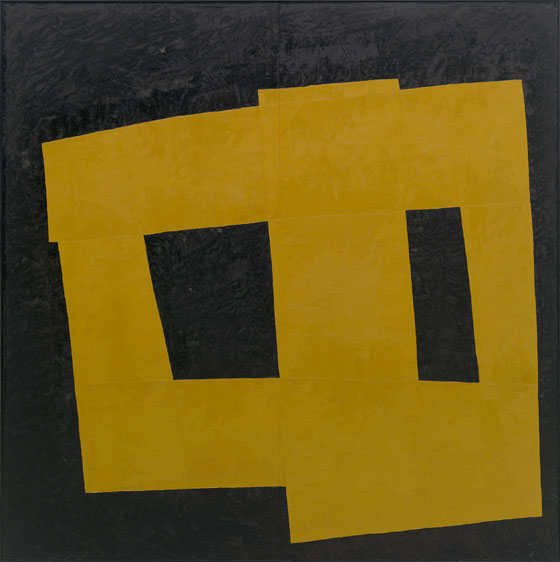 Takeo Yamaguchi. Work – Yellow (Unstable Square [Fuantei shikaku]). Oil on plywood. 182.6x182.6 cm. 1958 Publicity photos Courtesy Takeo Yamaguchi | |
| One of the pivotal moments in the museum’s history was the unveiling of architect Frank Lloyd Wright’s iconic building in 1959 with a major exhibition staged by the then-director James Johnson Sweeney. Sweeney was one of the first influential museum curators who saw the potential of abstract art and turned it into the cornerstone of his museum’s collection. It would only be a slight overstatement to say that the spirit of the lonesome hero, a cowboy fighting for justice and pushing back the frontiers, has been highlighted not only through the public figures among the heroes of American abstract expressionism like Jackson Pollock, but also by the leaders of institutions who have, to a great extent, shaped the public image of those artists and thus paved the way for the global market of modern art. Great significance is attached here to the mythology of personalities – in some respects, Sweeney is New York’s cultural hero, just like, say, Alfred Barr, the first director of the Museum of Modern Arts (MoMA), or William Rubin, long reigning director and curator of painting and sculpture at the MoMA. Here one can see certain parallels with the enthusiasm often encountered in American culture for the heroism and individualism of their leaders, accepted without the slightest hint of irony or scepticism. Otherness as a goal Art of Another Kind largely refers to the 1959 exhibition, but it is not its direct replica, rather a slightly improved version. Its name has been borrowed from a book by French critic and curator Michel Tapié, ‘Art of Another Kind’ (Un art autre, 1952). Tapié is considered a founder theorist of European abstract art. Abstraction as radical otherness – in the spirit, not only by the letter – was extolled in the accompanying texts to the exhibition, highlighting the irreversible rejection of any connection with the figurative art tradition and the glorification of an artist’s individualism that took place in the 1950s. Otherness and individualism was even more graphically expressed during that same decade by the museum building of Wright’s design – the unexpected curved shapes which, undeniably, stood out against the background of the primitively rectangular grid of New York City streets and its equally rectangular houses. By alluding to the book by the French author in the exhibition title, the Guggenheim Museum is trying to present the idea of abstract painting as a global movement, underlining at the same time that the role of pioneers and groundbreakers in the movement irre-futably belongs to American artists. What’s more, the radical turning point towards abstraction, from the Guggenheim’s perpective, is mainly to do with formal aspects – just like back in 1959, so also in 2012 the considerably different social, economic and political conditions that affected and promoted the development of abstractionism in European countries are ignored. Countless volumes of academic research have been devoted to the analysis of postwar history of Europe and the USA, and it is perfectly clear that in Europe of the 1950s there were far more things that were different rather than in common with America of the 50s, also in art. Serge Guilbaut once noted that the pioneers of French abstract painting – art informel – propagated an equally negative attitude, not only against figurative painting and the realism advocated by French communists, but also towards the “cold abstraction” of modern American art.(1) At the Guggenheim Museum those differences do not exist, and it has been assumed that artists all over the world in the 1950s simply embraced abstraction as a new means of expression. But let’s start at the beginning. | |
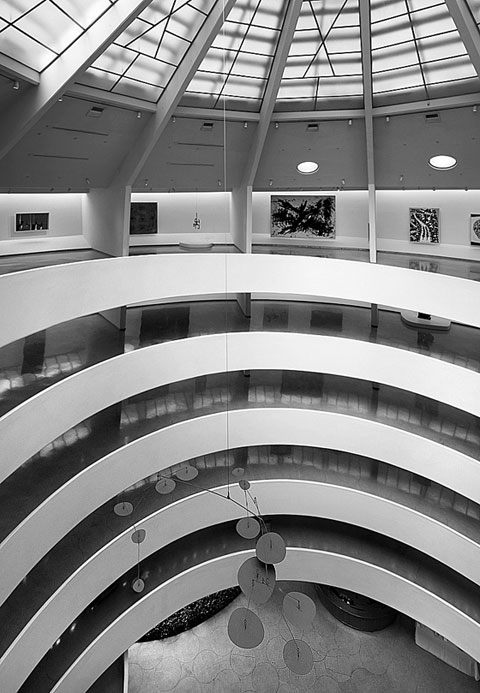 Art of Another Kind: International Abstraction and Gugenheim, 1949–1960. View from the exhibition Photo: David Heald Publicity photos Courtesy of the Solomon R. Guggenheim Foundation | |
| The first work to greet viewers was Jackson Pollock’s canvas Untitled (Green Silver) (1949) – somewhat predictably, given Pollock’s status as a cult figure in American culture. Right next to the entrance, a small anteroom offered a summary of the exhibition for those in a hurry: a short course in abstract painting, comprising works by Alberto Burri, Karel Appel, Franz Kline, Kenzo Okada, Jimmy Ernst, one painting each, and another Pollock. Thereafter, the viewer had to do the six ritual circles along Wright’s ramp, first being introduced to American, then European abstract art, and the exposition concluded with Takeo Yamaguchi’s majestic Work – Yellow (Unstable Square) (1958). Although the exhibition includes works by Japanese and other Asian artists, it should be noted that in the 1950s these artists lived and worked in New York, and that they represent the art scene in America. Anti-intellectualism and neo-aestheticism Frank Lloyd Wright’s authoritarian construction demands that the works of art (more specifically, paintings) are to be placed along the walls of a spiral ramp, and directs the flow of the public in an unrelenting one-way mass procession (going up or down the ramp). Thus the viewer has no other option but to obediently follow the narrative designed by the museum through the sequence of works. What’s more, from the second floor upwards, Wright has designed the lower part of the wall slanting slightly outwards, keeping visitors at an ever increasing distance from the works of art. This can sometimes be quite irritating – no doubt, one should respect art, but often enough it is so vital to inspect the finer details on the surface of a painting close-up, which is impossible to do at a distance of one metre. This interesting architectural element, affectionately called “skirts” by the musem staff, reminds one of the inu-yarai, an arched bamboo screen on the outer wall of a house, a frequently-used feature in traditional Japanese architecture. This has a similar function to that of Wright’s “skirts” – to keep beasts and humans at a safe distance from the house, thus protecting it from damage and the excessively inquisitive gaze of strangers, or their eavesdropping.(2) Both factors determined by the museum’s architecture – the compulsory one-way movement in which the viewer is a passive receptor of the museum’s authoritative narrative, and the displaying of paintings at a safe distance from the audience – further heightened a sense of physical and psychological alienation in this exhibition. The artworks here were artificially dissociated both from the audience and any context whatsoever beyond art itself (except for the frequent references to Sweeney’s historic exhibition), which these days could be seen as a somewhat reactionary and even anachronistic approach to exhibition praxis. This revives the American anti-intellectual and formalist attitude towards art which crystallised precisely in the 1950s. For example, Patricia Leighten characterizes this decade as the epoch when “with the menace of McCarthyism, and the country’s most respectable intellectuals proclaiming “the end of ideology,” it [was] understandable that American art historians would retreat into a neo-aestheticism.”(3) Art of Another Kind could be viewed as a demonstration lesson in 1950s neo-aestheticism. Paintings in the exhibition were grouped by analogy of purely formal qualities, but the accentuation of these more often than not fails to reveal or explain anything really significant. For instance, Antonio Saura’s painting Adios (1949) had been placed next to Luis Feito’s No.175 (1960) only because of the similar, almost monochrome colour scheme used in both paintings. Ellsworth Kelly’s Green and White (1951), dominated by green wedge-shaped figures on a white background, had been displayed side by side with Jean Tinguely’s White Moving Forms on Black Background (TNT) (1957) just because Tinguely’s work contains wedge-shaped metal sheets. Cy Twombly’s painting Untitled (1960) and Gastone Novelli’s A Gallery of the Museum (1960) have only one thing in common: both works make use of letters and words. The invitation to appreciate only purely decorative functions considerably narrows the possibilities of interpretation and renders art politically harmless. This approach is further accentuated in the accompanying texts by the excessive attention paid to brushwork and various innovative methods of applying paint. After a couple of rounds, the audience comes to perceive the works on display only as intriguing exercises and experiments in painting techniques. However, presumably, much more often – if not always – the origin and impact of those works reaches far beyond the boundaries of painting as a craft, and it would be more worthwhile to speak about the artists’ ideals, their political convictions, personal traumas and the nature of postwar life as something that provided the background for, and interacted with, abstractionist trends in painting. | |
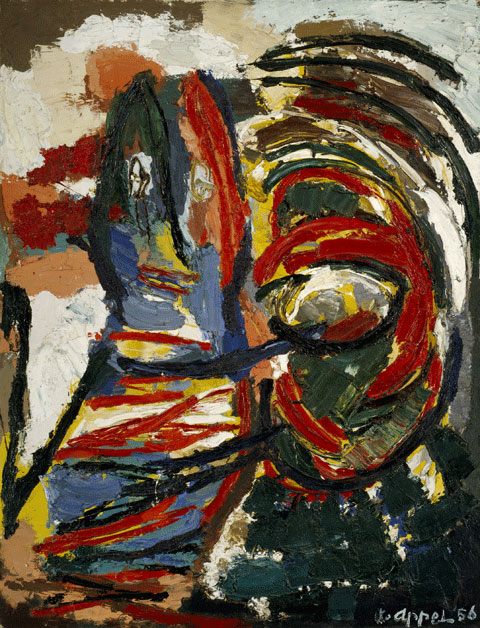 Karel Appel. The Crying Crocodile Tries to Catch the Sun. Oil on canvas. 145.5x113.1 cm. 1956 Publicity photos Courtesy of the Karel Appel Foundation; Artists Rights Society (ARS), New York | |
| Instead, the Guggenheim Museum pursues formal analysis and is tireless in pointing out that the main things to observe are “the angular, graphic slashes of black on white” in Emilio Vedova’s work Image of Time (Barrier) (1951), “the inherent beauty of natural, ephemeral materials and unconventional mediums” in Alberto Burri’s Composition (1953) and the “physicality of the thick application of paint and the boldness and brutality of brushwork” in Karel Appel’s painting The Crying Crocodile Tries to Catch the Sun (1956).Stories about artists who “squeezed paint directly from tubes onto the canvas” (a comment on Georges Mathieu’s Painting (1952)), “dripped and poured enamel paints on canvases and papers” (Jackson Pollock’s Ocean Greyness (1953)), or even “applied paint with a long and flexible knife, then spreading and flattening it into diagonal bands with a bent curtain rod” (Judit Reigl’s Outburst”(1956)) literally confine the artists to their studios and oust their creation from the complex and multifaceted structure of social, economic and political processes. Art rendered harmless Artificial separation of art from life is misleading, especially as regards European artists such as Lucio Fontana, Jean Dubuffet, Asger Jorn and others who, in their time, emphasised something completely different – the wish to integrate art into a broader context. So, for example, Dubuffet believed that art “would be a very direct and very sincere expression of our real life and our real moods”.(4) Fontana once said that art “encompasses the four dimensions of existence”.(5) And, although in his interviews Burri always denied the presence of any content in his works other than a quest for form, art historians tend to point to the close connotations of one of his favourite materials, hessian, with the not-so-brilliant conditions in postwar Italy and the ambivalent attitude towards economic aid from America (Burri often used sacks that had been used for American food deliveries, leaving the inscriptions visible).(6) In the Guggenheim Musem, however, the voices of individual artists are being muffled, turning the Art of Another Kind into a harmless parade of rectangular multicoloured canvases. Romy Golan has emphasised that in the 1950s artists were trying to avoid the unwelcome affinity “between large-scale painting and decorativity.”(7) By way of a paradox, that unwelcome analogy is achieved here. Painting is “liberated” of any interaction with the world outside painting itself. Truly, the rhetoric of freedom – be it the “freedom of the brush” referred to by Daniel Catton Rich, or Michel Tapié’s free individual capable of “something radically new” – is a fundamental element in the exhibition’s publicity campaign.(8) Unfortunately, the use of the concept of freedom remains at the level of rhetoric, without delving into a deeper undertanding of it, even though “freedom” and “individualism” for abstractionists in the 50s were concepts with specific political connotations. Abstract painting as a symbol of free artistic expression was included in the propaganda arsenal of American capitalism and consumerism during the Cold War. Paintings by Jackson Pollock and other abstract expressionists were displayed next to modern washing machines, colour TVs, cars and Pepsi Cola stands in Moscow during the 1959 American National Exhibition, the aim of which was to demonstrate to the ideological foe absolutely all the achievements of the “free” world.(9) | |
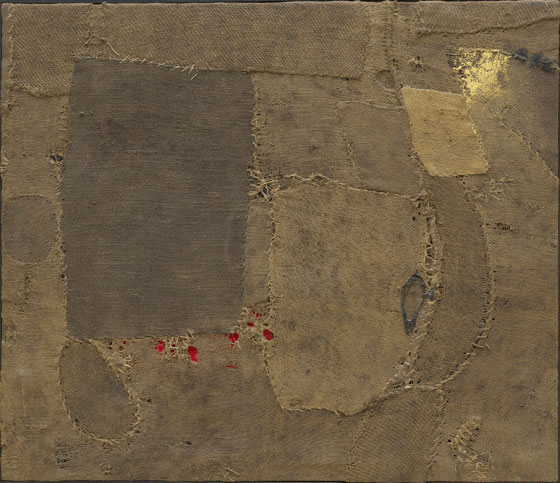 Alberto Burri. Composition. Oil, gold paint, and glue on burlap and canvas. 86x100.4 cm. 1953 Publicity photos Courtesy Artists Rights Society (ARS), New York; ADAGP, Paris; SIAE, Rome; Solomon R. Guggenheim Foundation, New York | |
| The real “others” – women and sculptors The choice of works for the exhibition brings up at least two material questions. Firstly, it is obvious that the exposition almost completely ignores female artists; only six among the seventy artists are women, represented with seven works out of about one hundred. This ratio reflects quite accurately the far from democratic or egalitarian nature of the museum’s acquisition policy. Neither during Sweeney’s time nor later did the Guggenheim Museum seek to purchase works by women, and canonised men’s achievements only. One of the exceptions is the work Ireland (1958) by American artist Grace Hartigan, acquired for Peggy Guggenheim’s collection in Venice almost twenty years after it was painted, in 1976. The works by other women artists, however, came to the Guggenheim not as purchases, but as gifts. The dismissive attitude towards female artists smacks of an outdated patriarchalism, which is all the more surprising due to the fact that the curators of Art of Another Kind are women – Tracey Bashkoff and Megan Fontanella. Moreover, the few works by women included in the exhibition seem to have been chosen almost at random, and accompanying texts do not even touch upon the issue of women’s participation and role in the development of abstract art. Although most of the works in the exhibition are accompanied by a couple of paragraphs of comments, some of the works by women artists carry the title only. This stinginess of expression allows the silencing of anything that could bear witness to women’s artistic and intellectual activities, focusing instead only on the decorative qualities of the paintings. That is very convenient, because it permits the avoidance of, for instance, any discussion on the political views of Italian artist Carla Accardi (she was a member of the Forma 1 group of artists whose manifestos proclaimed a Marxist position).(10) Some other comments highlight the anachronistic division between “men’s art” and “women’s art” – the annotation to Maria Helena Vieira da Silva’s painting Aix-en-Provence (1958) comments that her works are “recognized for her dynamic and intricately woven compositions”, thus referring, totally out of place, to the traditional prejudice that a woman’s role in art is confined to weaving and all other handicrafts, while paintings created by men have been endowed with heroic and aggressive epithets such as “a violent battle of opposites” in Mark Rothko’s works or “violent color contrasts” in the canvases by Karel Appel. Another major objection about the selection of works relates to the hierarchy of medium. I believe it would have only been to the benefit of the exhibition, that the museum could actually afford to mount an exhibition of abstract painting. By attaching the word “art” to the title, the prospective audience is being promised a seemingly all-embracing and multimedial experience – it doesn’t matter that in fact it was an exhibition of painting, with a couple of minute and insignificant sculptures in a corner here and there. Until now I had been convinced that this kind of an attitude is to be encountered only in the remotest fringes of the world, far removed from major centres – in the former post-Soviet space, where museum workers still subscribe to notions of the Soviet official art media hierarchy and consider that almost every 20th century local art exhibition will only benefit if painting, the highest of the arts, is enhanced with some sheets of graphic art, a couple of sculptures and a handful of examples of medal art. Now it is crystal clear that this is how it must be done, seeing that this is what they do even at the Guggenheim Museum: while looking at the large-scale paintings and moving upwards along the ramp, a couple of times it was possible to trip over one pedestal or another surmounted by a tiny sculpture. Sculpture has never been at the core of the Guggenheim acquisition policy, and thus the few objects displayed neither give the idea of participation by this medium in the walk of triumph towards abstraction, nor significantly contribute to, or interpret the message of the paintings. The only rational reason imaginable for the curious presence of sculpture is an excuse for displaying, in the place of honour – the centre of the atrium, Alexander Calder’s Red Lily Pads (1956), since for some completely inexplicable reason the American public loves everything Calder’s hand ever touched. | |
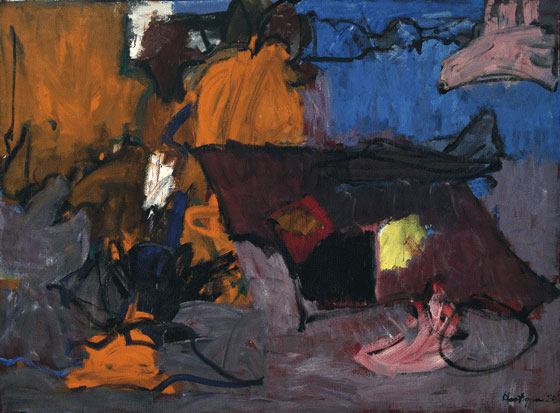 Grace Hartigan. Ireland. Oil on canvas. 200x271 cm. 1958 Publicity photos Courtesy of the Grace Hartigan Estate | |
| On the whole, the exhibition left mixed impressions and promoted a melancholic reflection on the splendours and miseries of the avant-garde. In the 1950s, Frank Lloyd Wright’s building symbolised the most original achievement possible in architecture. Wright’s design of the main exhibition hall as an uninterrupted helical ramp the height of six storeys was something never seen before and quite shocking. Likewise, James Johnson Sweeney’s acquisition policy was unique and daring for its time. But everything looks different today. Although we can appreciate the architect’s skill of spinning visual and spatial intrigue by “coiling up” the exterior and the interior of the building from concrete strips, half a century later its architectural splendour seems tired and anachronistic. Adaptation and changeability could be some of today’s catchwords, but precisely these concepts are totally inapplicable to Wright’s building, in which everything will always be subject to the architect’s intentions, disregarding the efforts of some curator or other to break or circumvent the restrictions of the space. For example, Maurizio Cattelan’s retrospective in late 2011 merely created an illusion of overcoming the space – by concentrating all the works of art in the atrium only, suspending them from the ceiling, actually emphasised Wright’s presence even more. Wright will always command the parade at the Guggenheim Museum in New York and, most probably, this museum – although physically intact and well-preserved – will turn into the metaphorical ruins of postwar avant-garde art. This coil of concrete will always loom at the end of Fifth Avenue as a monument to American idealism of the 1950s and the successful attempts of instrumentalising art as a weapon for political struggle, as a monument to an outdated and unwholesome attitude towards art and the glorification of social, economic, gender and other inequalities. This is exactly what ruins and other historic monuments do – testify, by their physical presence, to the values and dreams of a bygone epoch. Translation into English: Sarmīte Lietuviete (1) Serge Guilbaut, “Postwar painting games: The rough and the slick,” in Reconstructing modernism: Art in New York, Paris, and Montreal, 1945–1964, ed. Serge Guilbaut (Cambridge, Mass.: MIT Press, 1990), p. 32; p. 52. (2) I am grateful to art historian Yusuke Isotani for pointing to the relevant term in Japanese traditional architecture. (3) Patricia Leighten, “Revising Cubism,” Art Journal 47, No. 4 (1988), p. 272. (4) Jean Dubuffet, “Anticultural Positions (1951),” in Theories and documents of contemporary art: A sourcebook of artists’ writings, eds. Kristine Stiles and Peter Howard Selz (Berkeley: University of California Press, 1996), p. 192. (5) Lucio Fontana, “The White Manifesto (1946),” in Art in theory, 1900–1990: an anthology of changing ideas, eds. Charles Harrison and Paul Wood (Oxford, UK; Cambridge, Mass., USA: Blackwell, 1993), p. 647. (6) Jaimey Hamilton, “Making Art Matter: Alberto Burri’s Sacchi,” October 1, No. 124 (2008), p. 47. (7) Romy Golan, “L’Éternel Décoratif: French Art in the 1950s,” Yale French Studies, No. 98 (2000), p. 102. (8) Daniel Catton Rich’s “fredom of the brush” has been mentioned by Megan Fontanella, one of co-curators of the exhibition, in an informational video on the exhibition accessible on the museum’s website at www.guggenheim.org. Michel Tapié quoted after: Michel Tapié, “From An Other Art,” in Art in theory, 1900–1990: an anthology of changing ideas, eds. Charles Harrison and Paul Wood (Oxford, UK; Cambridge, Mass., USA: Blackwell, 1993). Pp. 619–620. (9) See: Jack Masey and Conway Lloyd Morgan, Cold War confrontations: US exhibitions and their role in the cultural Cold War (Baden, Switzerland: Lars Müller, 2008), 152–282; and Susan E. Reid, “Who will beat whom? Soviet popular reception of the American National Exhibition in Moscow, 1959,” in Imagining the West in Eastern Europe and the Soviet Union, ed. György Péteri (Pittsburgh: University of Pittsburgh Press, 2010), pp. 194–236. (10) Forma1, “Manifesto (1947),” in Roma-New York, 1948–1964: An art exploration, eds. Germano Celant and Anna Costantini (Milano: Charta, 1993), pp. 44–45. | |
| go back | |







